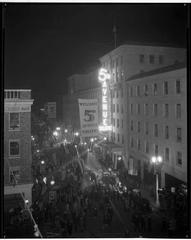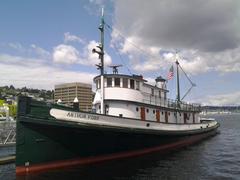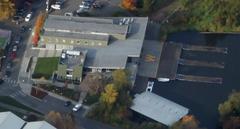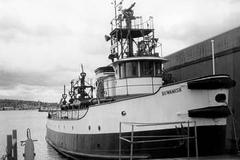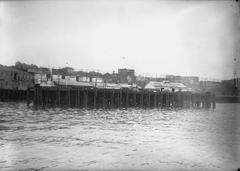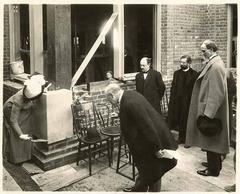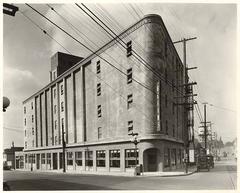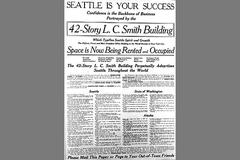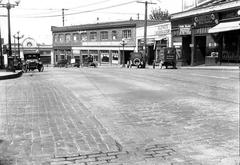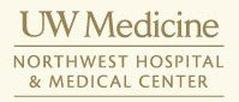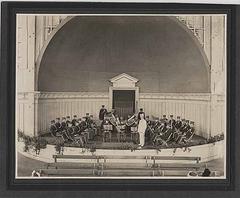
Henry M. Jackson Federal Building Seattle: Visiting Hours, Tickets, and Historical Significance
Date: 04/07/2025
Introduction
The Henry M. Jackson Federal Building (JFB) is a prominent fixture in downtown Seattle, representing both the city’s federal presence and its architectural evolution. Completed in 1974 and renowned for its modernist design, the building serves as a central hub for numerous federal agencies while offering visitors insight into Seattle’s historical development, civic identity, and commitment to public service. Whether you are an architecture enthusiast, history buff, or seeking government services, this guide offers detailed information on the building’s history, visiting hours, admission policies, and tips to make your visit rewarding. For official updates and deep historical context, consult the GSA site and Wikipedia.
Historical Background
Site Origins and Federal Expansion
Located at 915 2nd Avenue, the site of the JFB is steeped in Seattle’s earliest history. Local tradition holds that city founders A.A. Denny, William Bell, and C.D. Boren landed here in 1851, laying the foundation for modern Seattle (GSA.gov). The area’s significance increased after the Great Seattle Fire of 1889, which began at this location and reshaped the city’s commercial core.
By the early 20th century, Seattle’s importance as a regional and national gateway—especially during the Klondike Gold Rush—led to a proliferation of federal offices. The need for a consolidated federal presence culminated in the construction of a new office building, with Congress allocating over $2 million in 1928 for the project (GSA.gov).
Architectural Development and Significance
The present JFB was designed by Fred Bassetti & Company and John Graham & Associates, with landscape architect Richard Haag contributing to its public spaces (Wikipedia). Unlike the glass-and-steel towers typical of the era, the JFB is distinguished by its use of precast concrete panels, chamfered corners, and a distinctive metal hipped roof (SAH Archipedia). These choices echo the city’s architectural heritage and the late 19th-century structures that once occupied the site.
A unique feature of the JFB is the integration of salvaged elements from the Romanesque Burke Building (1889–1891), particularly the signature entry arch, now a focal point of the building’s plaza (PCAD). This adaptive reuse was an early example of preservation in the face of urban renewal.
Federal Tenancy and Urban Context
Upon opening in 1974, the building consolidated over 50 federal agencies, improving operational efficiency and emphasizing the federal government’s commitment to serving the Pacific Northwest (Wikipedia; GSA). Its location places it within walking distance of other major Seattle landmarks such as Pioneer Square and Pike Place Market, further cementing its place in the city’s urban and civic landscape.
Honoring Senator Henry M. Jackson
In 1983, the building was renamed to honor U.S. Senator Henry M. Jackson, a prominent Washington legislator known for his work on environmental, defense, and civil rights issues (Wikipedia). This dedication reflects the building’s ongoing significance as a center of public service and civic engagement.
Historic Recognition
The JFB’s addition to the National Register of Historic Places in 2024 highlights its architectural merit and role in Seattle’s federal and civic history (Wikipedia). This status ensures that preservation standards will guide future modifications.
Architectural Features and Urban Identity
Standing 37 stories tall and reaching 148.4 meters, the JFB is a notable example of late modernist architecture (Skyscraper Center). The building’s concrete-steel composite structure was engineered for seismic resilience, while its exterior design references the city’s historic architecture.
The public plaza showcases the Romanesque arch from the Burke Building and offers landscaped areas for public gatherings, protests, and community events. These spaces, designed by Richard Haag, foster civic engagement and provide a welcoming environment for visitors (Wikipedia).
Inside, the lobby and public spaces feature open layouts, durable materials, and natural light, while hosting public art installations by regional artists. The building’s design represents a conscious effort to balance progress with heritage and serves as a model for civic architecture in Seattle (SAH Archipedia).
Visiting the Henry M. Jackson Federal Building
Location and Getting There
- Address: 915 2nd Avenue, Seattle, WA 98174
- Easily accessible by public transit: the nearest light rail station (Symphony) is a four-minute walk, and multiple bus stops are nearby (Moovit).
- Several public parking garages are available in the downtown area, but parking can be expensive or limited during peak hours.
Visiting Hours
- Public Hours: Monday through Friday, 8:00 AM to 5:00 PM.
- Closed on federal holidays.
- Hours for specific agencies may vary; check before your visit.
Admission and Tickets
- Admission: Free; no tickets required for public areas.
- Government-issued photo ID required for entry.
- All visitors must pass through airport-style security screening.
Accessibility
- The building is fully ADA compliant, with accessible entrances, elevators, and restrooms.
- Assistance is available at the entrance upon request.
Security Procedures
- Airport-style screening includes metal detectors and X-ray machines for bags.
- Prohibited items: weapons, sharp objects, and certain electronics.
- Photography is generally allowed in exterior and public plaza areas, but is restricted inside, especially in sensitive or secure zones.
Guided Tours and Special Events
- While regular public tours are not offered, the JFB is featured in city architectural walking tours, such as those organized by the Seattle Architecture Foundation.
- The “City & the Sound: Seattle’s Waterfront” tour and other free thematic walks begin at or near the building (Seattle Architecture events calendar).
- Special events, such as “Federal Building Fridays,” are held on the plaza, supporting civic engagement and advocacy (Seattle Indivisible).
Services for Veterans and the Public
- The first floor houses the U.S. Department of Veterans Affairs Seattle Regional Office.
- Walk-in appointments are accepted from 8:00 AM to 4:00 PM, Monday through Friday (VA Operational Status).
- Use the VERA portal to schedule, reschedule, or cancel appointments.
- Other federal agencies, such as the IRS and Social Security Administration, also operate within the building.
Nearby Attractions
- Pioneer Square: Seattle’s oldest neighborhood, rich with history and architecture.
- Pike Place Market: Iconic public market offering food, crafts, and views of the waterfront.
- Seattle Art Museum: Major exhibitions and local collections.
- Smith Tower: Historic early skyscraper with an observation deck.
Visitor Tips
- Arrive Early: Allow time for security screening, especially during events or busy periods.
- Bring ID: Government-issued photo identification is required.
- Check for Events: Review local event calendars and the Seattle Architecture events calendar for tours or civic gatherings.
- Respect Security: Follow all posted protocols regarding prohibited items and photography.
- Use Transit: Maximize convenience and minimize parking hassles by taking public transportation.
Frequently Asked Questions (FAQ)
Q: Are tickets required to visit the Henry M. Jackson Federal Building?
A: No, admission to public spaces is free and tickets are not required.
Q: What are the building’s hours?
A: Open Monday through Friday, 8:00 AM to 5:00 PM, except federal holidays.
Q: Is the building accessible for visitors with disabilities?
A: Yes, the building is fully ADA compliant.
Q: Can I take photos inside?
A: Photography is generally allowed in exterior and public areas, but may be restricted inside due to security.
Q: Are there guided tours?
A: No regular tours, but the building is included in Seattle’s architectural walking tours. Check with the Seattle Architecture Foundation for schedules.
Q: What federal services are available?
A: The VA Regional Office, IRS, Social Security Administration, and others provide services; check agency websites for hours and appointment requirements.
Visuals and Media Recommendations
For an enhanced visitor experience, include high-quality images of:
- The building’s exterior and plaza, emphasizing its modernist design and the Romanesque Burke Building arch.
- The public lobby and landscaped entrance.
- Interactive maps showing the building’s location relative to Pioneer Square, Pike Place Market, and public transit.
Use descriptive alt text such as “Henry M. Jackson Federal Building visiting hours” and “Seattle historical sites.”
Cultural and Civic Significance
The Henry M. Jackson Federal Building stands as a testament to Seattle’s resilience, architectural innovation, and civic values. Its preservation and integration of historic elements—such as the Burke Building arch—demonstrate a commitment to the city’s layered history. The building’s role as a venue for public gatherings and civic engagement continues to shape Seattle’s urban and cultural landscape.
Plan Your Visit and Stay Connected
For the latest information on hours, security, and events, consult the GSA website and the VA Seattle Regional Office page. Download the Audiala app for guided tours and up-to-date travel tips. Follow local organizations and social media channels for news and event updates. Share your experiences using #SeattleHistoricVisits!
References and Further Reading
- General Services Administration (GSA) – Henry M. Jackson Federal Building
- Wikipedia – Henry M. Jackson Federal Building
- Skyscraper Center – Henry M. Jackson Federal Building
- Seattle Architecture Foundation – Events and Tours
- Library of Congress – Henry M. Jackson Federal Building
- Moovit – Public Transit to Henry M. Jackson Federal Building
- Seattle Indivisible – Federal Building Fridays
- U.S. Department of Veterans Affairs – Operational Status
- PCAD – Burke Building
- SAH Archipedia – Henry M. Jackson Federal Building



